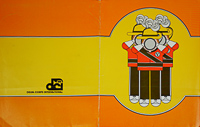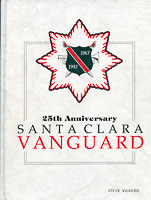Santa Clara Vanguard
Santa Clara, CA United States
Founded: 1967
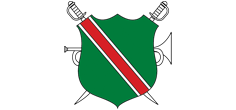
World Class
Results from final championship competition of the year
|
|---|
| Repertoire for 2000 |
The Age of Reverence |
| Prayers of Kierkegaard, Prayer No. 4 by Samuel Barber S. Barber Lovers/Prayers Of Kierkegaard |
| String Quartet No. 4, mvt 5 Allegro Molto by Bela Bartok |
| Piano Concerto No. 1, mvt 3 by Bela Bartok |
| Agnus Dei (Adagio for Strings) by Samuel Barber S. Barber Adagio |
| Stained Glass by David Gillingham |
CORPS Photos
The Santa Clara Vanguard Drum and Bugle Corps is a World Class competitive drum and bugle corps. based in Santa Clara, California.
On the evening of March 6, 1967, the parent-boosters of the Sparks Drum & Bugle Corps, unhappy with the corps' artistic direction, voted to shut down the corps and return the unit to being a drum and bell corps with majorettes.
After the fatal vote, three dissenting adult staff-supporters met with concerned corps members and asked them if A) they would rather continue as a drum and bugle corps, or B) become a drum and bell corps. When the members resounding chose "A," a new corps was born, and a new booster club was organized on the spot. Gail Royer, who was a music instructor for the Sparks, a local elementary music teacher, and an American Legion music judge was picked as the director for the new corps. The naming of the corps was delayed until the new group's first scheduled rehearsal, a week later. At that time, after discussing several possibilities, the members and staff named their new corps the Santa Clara Vanguard.
Only week later, the brand new corps marched in its first parade and won the San Francisco’s St. Patrick’s Day Parade.
The big trip in 1967 was to Southern California for the Anaheim Kingsmen’s second annual Festival of Music contest. The corps placed fourth there, but they also saw a performance by the U.S. Air Force Academy Drum & Bugle Corps, giving them a taste of what was possible in the drum corps medium. It was also the weekend that they met Pete Emmons and Fred Sanford, two young instructors with the Kingsmen who would play large roles in the Santa Clara corps’ future. . Just before the corps’ final performance of that first seasonr, Gail Royer honored the corps’ age-outs with the first Green Feather Ceremony, a rite that would become a corps tradition.
As with most corps of the day, several of the brass arrangements played during the corps’ early years were written by Truman Crawford, director of the U.S. Marine Corps Drum & Bugle Corps. Other early contributors to the brass book included Don Angelica and Keith Markey (with “fine tuning,“ contributed by Jack Meehan). Gail Royer began writing arrangments during the corps' first year, and he gradually took over more and more of the repertoire, until he was SCV's only brass arranger from 1970 through1980.
In 1968, the corps embarked on its first tour to the Midwest in order to measure itself against more experienced corps. Although they did not place high at any of the competitions, the tour was a success because of the competition experience and the exposure to the national competition scene. Corps members made many friends and gained the respect of fellow performers from such elite corps as the Troopers, Kilties, Cavaliers, and Blue Stars.
On the local front, the SCV Color Guard beat the Anaheim Kingsmen to win the 1968 California Color Guard Circuit Championship. The Vanguard won its first standstill competition, followed by its first public performance of "Procession of the Nobles" with the U.S. Air Force Academy Drum & Bugle Corps in the audience. On August 3, 1968, SCV won its first field contest at the Anaheim Kingsmen’s show. The corps was host of the first "Pacific Procession" field competition (named after "Procession of the Nobles")--- the audience was smaller than anticipated, with the assassination of Senator Robert Kennedy occuring only a few days before. Santa Clara Vanguard capped off its year by winning the first of many California State Open Championships.
"Procession of the Nobles" presented the corps with two challenges. First, no corps had ever played an entire piece in odd time while marching--- odd meters and tempos were reserved for the standstill portion of the show. Second, Royer’s arrangement of the chart included the original intro, with three measures of the opening rhythmic statement. Staff members quickly realized that this introduction meant that the drill would have to step off on the right foot--- a marching "no-no" at that time. It took Royer about one minute to solve the problem – rewriting the arrangement right in the middle of a drill rehearsal, he cut out one of the problem measures, and it all fell into step.
1969 was the first year the corps traveled to the East Coast. SCV made it onto a Fleetwood Records album by placing ninth in the World Open Finals. At the VFW National Championships in Philadelphia, the corps just missed making finals, losing to the Argonne Rebels for 12th spot by 0.15 of a point.
Following VFW Nationals, the Vanguard traveled to Washington, D.C., where they played a standstill concert on the steps of the Capitol building, The corps then went to New York City for four days of "cultural enrichment." On the long trip home, two station wagons broke down outside Aurora, Nebraska. Exhibitions in North Platte, Nebraska, and Elko, Nevada, went on without the passengers in those cars--- two soprano soloists, a third soprano, two lead baritones, and the entire French horn section. It was on the Eastbound stretch of the tour that, at the height of the Vietnam War, the guys in the corps learned their numbers for the national draft lottery.
Santa Clara Vanguard had already become a legitimate national contender in 1970. The corps won their first American Legion California State Championship, defeating the two powerhouse corps from Anaheim, the Kingsmen and the Velvet Knights. Six nights later in Racine, Wisconsin, before one of drum corps' toughest crowds, SCV's playing of Royer’s arrangements of music from "Fiddler on a Roof,” had even the stadium announcer shouting, "Wonderful Show! Wonderful Show!" That night, they were second to the Troopers, but by the end of the following weekend, Santa Clara had beaten practically everyone in the country. On July 11, 1970, at the North American Open in Milwauke's Marquette Stadium, the Santa Clara Vanguard left the field after being saluted by such legendary corps as the Troopers, Cavaliers, Madison Scouts, Blue Stars, Kilties, Argonne Rebels, Garfield Cadets, and DeLaSalle Oaklands. It was a defining moment in the history of the corps. and Royer told the corps' small staff on the sidelines, "We’ve finally made it!"
Due to limited finances, the corps was unable to travel to Miami to compete for the VFW National Championship that August. Instead, they carpooled to Portland, Oregon, and the American Legion Nationals. Competing against mostly West Coast corps, SCV won the 1970 American Legion Junior National Drum & Bugle Corps Championship while thier color guard also won the .Color Guard National Championship.
The Santa Clara Vanguard were urged by Cavaliers founder Don Warren and Troopers founder Jim Jones to join in starting a new organization run by the drum corps and free from the rigid, inflexible rules of the American Legion and VFW. The corps felt that not only were they having their creative potential as artistic performing groups stifled, but they were being financially starved. During the 1971 season, the "Midwest Combine," composed of the Blue Stars, Cavaliers, Madison Scouts, Santa Clara Vanguard, and the Troopers were not only booked into a number of shows together, but they found a host for a show of their own, which was a spectacular success. A simiar group called the United Organization of Junior Corps (also known as the "Alliance") was made up of five top-tier Eastern corps. In 1972, the ten corps from the Combine and the Alliance joined with three other top corps to form Drum Corps International (DCI), which remains as the sanctioning body for junior corps in North America. In the Combine shows, SCV had lost twice to the Troopers and were also behind the Cavaliers in one shoow.
Otherwise during that season, SCV competed in four "major" shows; the first three are known in the annals of the corps as "The Boston Massacre." The Vanguard was third at the CYO Nationals in Lowell, Massachusetts behind Blue Rock and the Anaheim Kingsmen. Of the thirty-seven corps at the World Open in Lynn, Massachusetts, Santa Clara placed second behind the 27th Lancers after winning prelims, and they were again behind 27 at the Danny Thomas Invitational in Lawrence, Massachusetts. Then a month later, while not winninga single caption, the Santa Clara Vanguard won both prelims and finals at the 1971 VFW National Championship in Dallas, Texas. Among the corps they beat at the Cotton Bowl were Blue Rock, Troopers, Anaheim Kingsmen, and the 27th Lancers--- four of the five corps that had finished ahead of them earlier in the season.
1972 was the inaugural season of the Drum Corps International World Championships. The Santa Claraa Vanguard, with a new look in uniforms of: red tunics, dark green pants/skirts, and dark green Aussie hats with curled white feathers, was among the favorites to win the crown. After the 39 corps prelims, SCV was the leader of the Top 12 corps that made Finals. However, in Finals they were passed not only by Blue Stars but by the surging Anaheim Kingsmen, who had kicked up their score by 3.6 points from prelims to become the first DCI World Champions. While Santa Clara did not win that night, they began an unbroken string of DCI Finals appearances that continues through 2017, a claim that no other corps can make..
In 1973, the Santa Clara Vanguard was a dominating force. They lost twice to the Troopers in July, but they won 27 contests that year. On August 17th, in front of 14,000 fans at Warhawk Stadium in Whitewater, Wisconsin, SCV won its first DCI World Championship.
The Vanguartd had played the music of "The Bottle Dance" from "Fiddler on the Roof" in both 1972 and '73. In 1974, SVC's guard did the bottle dance, bringing down the house at show after show. They lost a show early on to Troopers, and they were second behind the Madison Scouts at both DCI Midwest and the U.S. Open. After DCI prelims at Cornell University in Ithaca, New York, the corps was in third place, behind Madison and their prime rival, the Anaheim Kingsmen. Declining the defending champion's option of performing last, SCV added nearly three points to their prelims score in Finals. The audience reaction to the corps' performance was such a deafening roar that the Scouts and Kingsmen were unable to supress the Santa Clara Vanguard's charge to a second consecutive DCI Crown. In addition, they took High M&M, High Drums, and tied Madison for High GE. (The drumline had gone undefeated for its second consecutive year.) Also in that spectacular season, SCV introduced the lyrical tune that has gone on to become the song that spans the generations of SCV members and fans, "Send in the Clowns.”
An inspired 1975 finals performance earne the corps a perfect 30.0 in GE and a High Percussion score of 19.4, but still left Santa Clara in second place, 1.5 points behind the Madison Scouts.
Innovative drill in the form of a moving and revolving circle marked 1976. DCI also made its mark that year by officially approving two-valve horns, although they went on record as being, "permanently opposed to any three-valve horns in the future."
In 1977, the Vanguard and most major corps converted to two-valve horns, a move expected to add approximately five years to the life of the horns. The booster club continued to put the corps on the field in style, as the corps' mobile kitchen truck, "Miss Amana" made her debut and was the envy of all the other corps. For a corps that in its first few years had eaten a lot of its meals in fast-food restaurants and breakfasted on cornflakes from Dixie cups, this complete kitchen on wheels was a real luxury.
In 1978, fielding 10 snares, the corps performed selections from Khachaturian's "Gayne Ballet." The 34 girls in the color guard that year used a maypole and hoops instead of rifles, and performed the popular "Bottle Dance" once again. Although the corps took second or third most of the year, they peaked at the right time in August. In Denver, SCV scored 4.9 out of a possible 5.0 in Marching & Maneuvering and 29.8 out of a possible 30.0 in General Effect to win its third DCI championship.
The Vanguard's dominance during DCI's early days was partly due to superb drumming, partly due to innovative drill, but largely due to a strong, supportive organization
By 1980, most corps were executing field drills of circles, triangles, diamonds, arcs, X's and serpentine files. Only occasionally, cautiously, were asymmetrical patterns beginning to appear. SCV would close out the Seventies by falling to seventh place in Birmingham, Alabama in 1980 with a totally asymmetrical drill that was "extremely innovative” but slightly ahead of its time Also in 1980, DCI released its first state-of-the-art record album, professionally recorded in concert at the Concord Pavilion show on July 1, featuring the Santa Clara Vanguard and the Blue Devils.
Santa Clara recovered from the down season of 1980 by winning its fourth DCI World Championship in '81. Then, over the next seven years, SCV placed second five times and third twice before winning its fifth DCI title in 1989 with music from "Phantom of the Opera,".
During the run through the Eighties, SCV put velcro and magic on the field... changing the horn lines' tunics with a tear-away panel... changing the corps' pants while quickly passing through a tunnel... making members appear on the field... making members disappear to close the show... and then making the full corps disappear....
Following the 1989 championship, (as DCI allowed three valve bugles in 1990) SCV went into, for them, a down period; seven straight years of finishing no better than fifth. Even the corps' trademark "Fiddler" music could place no better than seventh in 1992.
After the '92 season, the corps' director since its founding, Gail Royer, stepped down, with few knowing he was terminally ill and would die soon after.
After five years of Broadway shows, a four year run from 1993-'97 featured music by European masters with no more success, with finishes of 7th, 5th, 6th, and another 5th.
In 1998, J.W. Koester's second season as director, the corps switched to American composers. That season's Bernstein program moved the corps back to third place at DCI. The next year's Copland show rose to take the Vanguard's seventh second place finish. In 1999, with an innovative music program from three Twentieth Century American composers--- Philip Glass, Frank Ticheli, and Samuel Barber--- the Santa Clara Vanguard won its sixth DCI World Championship.
Since winning the sixth title, SCV has remained a DCI Finalist under four different directors, extending the streak of Top 12 appeartances to 46 through 2017. The 2017 show, "Ouroboros" was a definite contender, earning the Santa Clara Vanguard its eighth second place finish.
[Vanguard Music and Performing Arts; A History of Drum & Bugle Corps, Vickers, 2002-03; Drum Corps World, multiple issues; Drum Corps International]
-
1968 1 scores
Highest Score 60.300
Final show in DCX Archives July 7, 1968 Dixon IL placed 6 with a score of 60.300
-
1969 6 scores
Highest Score 84.050
Final show in DCX Archives August 20, 1969 VFW Nationals-Preliminary Round Philadelphia PA placed 13 with a score of 84.050
-
1970 6 scores
Highest Score 82.500
Final show in DCX Archives October 3, 1970 California Open Unknown CA placed 1 with a score of 80.100
-
1971 17 scores
Highest Score 91.700
Final show in DCX Archives August 19, 1971 VFW Nationals Dallas TX placed 1 with a score of 89.950
-
1972 16 scores
Highest Score 87.700
Final show in DCX Archives September 2, 1972 California State Open Santa Clara CA placed 1 with a score of 83.450
-
1973 17 scores
Highest Score 91.300
Final show in DCX Archives August 19, 1973 Wisconsin State Fair West Allis WI placed 1 with a score of 91.300
-
1974 18 scores
Highest Score 89.500
Final show in DCX Archives August 18, 1974 Syracuse NY placed 3 with a score of 85.950
-
1975 16 scores
Highest Score 91.000
Final show in DCX Archives August 16, 1975 DCI World Championships Philadelphia PA placed 2 with a score of 91.000
-
1976 18 scores
Highest Score 89.500
Final show in DCX Archives August 21, 1976 DCI World Championships Philadelphia PA placed 3 with a score of 89.500
-
1977 20 scores
Highest Score 89.850
Final show in DCX Archives August 19, 1977 DCI World Championships Denver CO placed 3 with a score of 89.850
-
1978 22 scores
Highest Score 91.550
Final show in DCX Archives August 18, 1978 DCI World Championships Denver CO placed 1 with a score of 91.550
-
1979 8 scores
Highest Score 90.700
Final show in DCX Archives August 18, 1979 DCI World Championships Birmingham AL placed 3 with a score of 90.700
-
1980 24 scores
Highest Score 87.350
Final show in DCX Archives August 16, 1980 DCI World Championships Birmingham AL placed 7 with a score of 85.600
-
1981 20 scores
Highest Score 94.000
Final show in DCX Archives August 22, 1981 DCI World Championships Montreal QUE Canada placed 1 with a score of 94.000
-
1982 28 scores
Highest Score 94.650
Final show in DCX Archives August 21, 1982 DCI World Championships Montreal QUE Canada placed 2 with a score of 93.550
-
1983 32 scores
Highest Score 92.750
Final show in DCX Archives August 20, 1983 DCI World Championships Miami FL placed 3 with a score of 92.750
-
1984 28 scores
Highest Score 97.400
Final show in DCX Archives August 18, 1984 DCI World Championships Atlanta GA placed 3 with a score of 97.400
-
1985 33 scores
Highest Score 97.200
Final show in DCX Archives August 17, 1985 DCI World Championships Madison WI placed 2 with a score of 97.200
-
1986 27 scores
Highest Score 97.000
Final show in DCX Archives August 16, 1986 DCI World Championships Madison WI placed 2 with a score of 97.000
-
1987 26 scores
Highest Score 97.800
Final show in DCX Archives August 15, 1987 DCI World Championships Madison WI placed 2 with a score of 97.800
-
1988 31 scores
Highest Score 96.900
Final show in DCX Archives August 20, 1988 DCI World Championships Kansas City MO placed 2 with a score of 96.900
-
1989 35 scores
Highest Score 98.800
Final show in DCX Archives August 19, 1989 DCI World Championships Kansas City MO placed 1 with a score of 98.800
-
1990 32 scores
Highest Score 94.200
Final show in DCX Archives August 18, 1990 DCI World Championships Buffalo NY placed 6 with a score of 94.000
-
1991 31 scores
Highest Score 94.700
Final show in DCX Archives August 17, 1991 DCI World Championships Dallas TX placed 4 with a score of 94.400
-
1992 32 scores
Highest Score 92.100
Final show in DCX Archives August 15, 1992 DCI World Championships Madison WI placed 7 with a score of 91.800
-
1993 31 scores
Highest Score 91.100
Final show in DCX Archives August 21, 1993 DCI World Championships Jackson MS placed 7 with a score of 90.400
-
1994 25 scores
Highest Score 93.700
Final show in DCX Archives August 20, 1994 DCI World Championships Foxboro MA placed 5 with a score of 92.300
-
1995 27 scores
Highest Score 92.500
Final show in DCX Archives August 12, 1995 DCI World Championships Buffalo NY placed 6 with a score of 91.900
-
1996 29 scores
Highest Score 94.000
Final show in DCX Archives August 17, 1996 DCI World Championships Orlando FL placed 5 with a score of 92.300
-
1997 28 scores
Highest Score 96.900
Final show in DCX Archives August 16, 1997 DCI World Championships Orlando FL placed 3 with a score of 96.900
-
1998 28 scores
Highest Score 97.900
Final show in DCX Archives August 15, 1998 DCI World Championships Orlando FL placed 2 with a score of 97.900
-
1999 29 scores
Highest Score 98.400
Final show in DCX Archives August 14, 1999 DCI World Championships Madison WI placed 1 with a score of 98.400
-
2000 33 scores
Highest Score 94.700
Final show in DCX Archives August 12, 2000 DCI World Championships College Park MD placed 4 with a score of 94.700
-
2001 30 scores
Highest Score 95.400
Final show in DCX Archives August 11, 2001 DCI Championships - DCI I Finals Buffalo NY placed 4 with a score of 95.350
-
2002 26 scores
Highest Score 96.000
Final show in DCX Archives August 10, 2002 World Championships Finals Madison WI placed 4 with a score of 95.650
-
2003 30 scores
Highest Score 95.150
Final show in DCX Archives August 9, 2003 DCI Championships - Div I Finals Orlando FL placed 5 with a score of 94.700
-
2004 35 scores
Highest Score 97.375
Final show in DCX Archives August 14, 2004 Tour of Champions San Jose CA
-
2005 29 scores
Highest Score 88.650
Final show in DCX Archives August 13, 2005 DCI World Championships - Div I Finals Foxboro MA placed 8 with a score of 88.650
-
2006 34 scores
Highest Score 93.550
Final show in DCX Archives August 12, 2006 DCI World Championships - Division I Finals Madison WI placed 6 with a score of 92.350
-
2007 33 scores
Highest Score 94.175
Final show in DCX Archives August 11, 2007 DCI World Championships Finals Pasadena CA placed 5 with a score of 94.175
-
2008 29 scores
Highest Score 93.625
Final show in DCX Archives August 9, 2008 World Class Finals Bloomington IN placed 7 with a score of 93.025
-
2009 30 scores
Highest Score 95.900
Final show in DCX Archives August 8, 2009 DCI World Championships World Class Finals Indianapolis IN placed 5 with a score of 95.650
-
2010 32 scores
Highest Score 92.450
Final show in DCX Archives August 14, 2010 World Class Finals Indianapolis IN placed 7 with a score of 92.000
-
2011 36 scores
Highest Score 92.200
Final show in DCX Archives August 13, 2011 DCI World Championship Finals Indianapolis IN placed 6 with a score of 92.200
-
2012 32 scores
Highest Score 94.450
Final show in DCX Archives August 11, 2012 DCI World Championship Finals Indianapolis IN placed 5 with a score of 94.450
-
2013 31 scores
Highest Score 96.850
Final show in DCX Archives August 10, 2013 DCI World Championship Finals Indianapolis IN placed 4 with a score of 96.850
-
2014 31 scores
Highest Score 96.075
Final show in DCX Archives August 9, 2014 DCI World Championships World Class Finals Indianapolis IN placed 4 with a score of 96.075
-
2015 31 scores
Highest Score 93.850
Final show in DCX Archives August 8, 2015 DCI World Championships World Class Finals Indianapolis IN placed 5 with a score of 93.850
-
2016 29 scores
Highest Score 95.300
Final show in DCX Archives August 13, 2016 DCI World Championship Finals Indianapolis IN placed 4 with a score of 95.300
-
2017 31 scores
Highest Score 97.700
Final show in DCX Archives August 12, 2017 DCI World Championship Finals Indianapolis IN placed 2 with a score of 97.600
-
2018 27 scores
Highest Score 98.625
Final show in DCX Archives August 11, 2018 DCI World Championship Finals Indianapolis IN United States placed 1 with a score of 98.625
-
2019 27 scores
Highest Score 96.600
Final show in DCX Archives August 10, 2019 DCI World Championship Finals Indianapolis IN United States placed 3 with a score of 96.600
Members (154)
| Member Name | Section | Years Involved |
|---|---|---|
| Abbott, Mark | Euphonium | 2001 |
| Amador, Jesse | Baritone | 1966 to 1972 |
| Arnold, Mackenzie | trumpet | 2001 to 2002 |
| Arnold, Mackenzie | mellophone | 2003 to 2004 |
| Atkin, Matt | Contra | 2009 |
| Ball, Dave | Percussion (Bass line) | 1974 to 1976 |
| Balleza, Nick | lead sop | 2005 to 2009 |
| Barreras, Ray | Mallets - Xylophone | 1981 |
| Beraun, Sergio | Soprano/Trumpet | 2005 |
| Bernard, Kevin | Trumpet | 2006 to 2007 |
| Bernstein, Alex | Euphonium | 2002 |
| Blue, Alex | Euphonium | 2004 |
| Blue, Alex | Baritone/Euphonium | 2006 to 2007 |
| Bostic, Daniel | Guard | 1988 |
| Brakewell, Paul | Mellophone | 2003 to 2005 |
| Brown, Erik | Trumpet | 2001 to 2002 |
| Brown, Erik | Mellophone | 2003 to 2004 |
| Buxbaum, Jo Ann | color guard | 1984 to 1986 |
| Cabrera, Michael | Colorguard | 2003 to 2005 |
| Chappell, Patrick | Baritone | 2005 to 2009 |
| Cordes, Lindsay | Trumpet | 2002 to 2003 |
| Craig, Charles | Mallets | 1981 to 1982 |
| Cuevas, Daniel | Colorguard | 2005 |
| Curnutt, Ben | French Horn | 2002 |
| Cuthbert, Scott | Snare | 1983 |
| Ellis, Clayton | Baritone | 1993 |
| Estrada, Eric | Drumline/Bass | 2001 to 2003 |
| Ferland, Kyle | Baritone | 2005 |
| Frost, Amy | Trumpet | 2003 to 2006 |
| Garcia, Andy | Color Guard | 2002 to 2003 |
| Garcia, Stacey | Baritone | 2004 |
| Giles, Tony | Alto/Flugel | 1981 to 1982 |
| Gilmore, Anthony | Bass Drum | 1980 |
| Ginsburg, Fonda | Pit | 1987 |
| Gipson, Derek | high brass coordinator | 2008 |
| Glahn, Jeff | French Horn | 1981 |
| Gofstein, Marc | Contra Bass | 1986 |
| Gray, Kurt | Mellophone | 2003 |
| Grimes, Mark | Baritone | 1974 to 1975 |
| Harrington, Don | Contra | 1974 to 1978 |
| Harrington, Don | Contra | 1974 to 1978 |
| Hassler, Jeff | Contra/Tuba | 1999 to 2002 |
| Hatheway, Dave | Baritone | 1981 |
| Hofius, Chris | Trumpet | 2003 |
| Hofius, Christopher | Trumpet | 2003 to 2006 |
| Holtz, Erin | Mellophone (Auditioning) | 2006 |
| Hoyt, Kirbie | Mellophone | 2005 |
| Hubka, Tom | Trumpet | 2003 to 2004 |
| Hunter, Matt | Cymbal Section | 1978 to 1979 |
| Hunter, Matt | Bassline | 1981 to 1982 |
| Irons, Mark | Euphonium/Drum Major | 1997 to 2001 |
| James, Bob | Soprano | 1986 to 1988 |
| Jones, Bobby | colorguard | 2003 to 2005 |
| Jones, Bobby | Colorguard | 2003 to 2006 |
| Jones, Erin | guard | 2003 |
| Kadrie, Julie | trumpet | 2004 |
| Khedekar, Shekhar | Snare | 2001 to 2002 |
| Kile, Andrea | Trumpet | 2002 to 2004 |
| Kim, John | Trumpet | 2001 |
| Kinoshita, Steve | Mellophone | 1984 |
| Krohn, Samantha | Mellophone | 2000 to 2003 |
| LaFountaine, David | Baritone | 1974 to 1975 |
| Langworthy, Daryl | Percussion | 1980 to 1981 |
| Lawson, Jerry | Euphonium | 1983 |
| Ledtje, Leah | Trumpet | 2005 |
| Lodigiani, Chris | Rifle | 1972 to 1976 |
| Luke, Curtis | Soprano | 1974 |
| Lumapas, Stevenson | Colorguard | 2004 to 2005 |
| MOORE, LESTER | CONTRA | 1976 |
| Majors, Aaron | Sop/Trumpet | 2004 |
| Martinez, Ben | Baritone and Contra | 1968 to 1972 |
| Martins, Kevin | Mellophone | 2005 |
| Matos, Julio | Soprano | 1989 |
| Matos, Julio | Mellophone | 1990; 1992 |
| Mavroudis, Emily | color guard (weapon) | 1997 to 2003 |
| McCall, Justin | Cymbal Line | 2003 |
| McCallie, Russ | Baritone | 2005 to 2009 |
| McCann, Brad | Contra | 2003 |
| McGill, Lauren | Euph | 2008 |
| McLaughlin, Daniel | Soprano/Mellophone | 2000 to 2006 |
| McLaughlin, Daniel | Hornline | 2000 to 2006 |
| McWilliams, Mike | Lead Soprano | 1977 to 1983; 1985 |
| Megargel, Alan | Lead Soprano | 1978 to 1980 |
| Mendoza, Paul | color guard | 1987 to 1988 |
| Miller, Dean | French Horn/Mellophone | 1984 to 1987 |
| Minor, Jesse | Trumpet | 2003 to 2006 |
| Molnar, Jeff | Baritone | 2005 |
| Moody, Paul | Horns | 1969 to 1973 |
| Moorman, Jeff | Euphonium | 2002 to 2003 |
| Nelson, Kayla | Baritone | 2005 |
| Noll, August Emile | snares | 2005 |
| O'Brien, Bill | Colorguard | 2004 |
| Oeland, Jim | Bass | 1968 |
| Oeland, Jim | Marching Timpani | 1969 to 1973 |
| Otani, Ray | Contrabass | 1981 |
| Owens, Dan | Lead Soprano | 1984 |
| Patlan, Charles | Baritone | 2004 |
| Poling, Laura | trumpet | 2002 to 2004 |
| Poulan, Key | Brass Arranger | 2003 |
| Poulan, Key | Program Coordinator / Brass Arranger | 2004 |
| Poulan, Key | Brass Arranger / Composer | 2003 to 2011 |
| Powell, Aaron | Mellophone | 2005 |
| Prentice, Christopher | Mellophone | 1999 |
| Preston, Chris | Trumpet | 2003 |
| Quick, Robert | Euphonium | 2005 |
| Rajpura, Jennifer | Colorguard | 2004 to 2005 |
| Rathbun, Travis | Baritone | 2003 to 2004 |
| Riebesehl, Dale | contra | 1986 |
| Ristau, Brendan | Bari/Euph | 2012 |
| Rivera, Joey | Bassline | 2000 |
| Roberts, Wes | French Horn | 2002 |
| Robinson, Brian | Color Guard | 2005 |
| Roquemore, Jordan | trumpet | 2005 |
| Rosen, Tracy | Mellophone | 2006 |
| Rouleau, Michel | Mellophone | 1988 |
| Rountree, Christopher | Baritone | 2003 to 2004 |
| Roy, Jonette | Colorguard | 1973 to 1975 |
| Saldana, Luis | Euphonium/Drum Major | 1999 to 2000; 2002 to 2004 |
| Salvatore, Joe | Drumline - Cymbals | 1989 |
| Saul, Ryan | Pit | 1999 |
| Schwartz, Andy | Euphonium | 2002 to 2003 |
| Scipio, Ronald | Baritone | 2007 |
| Scipio, Ronald | Euphonium | 2008 to 2009 |
| Senninger, Kiel | Trumpet | 2004 |
| Shields, Laura | Front Ensemble | 2003 |
| Shulman, Stuart | Contra/Drum Major | 2001 to 2003 |
| Simon, Natan | trumpet | 2002; 2004 |
| Smith, Joe | Mellophone | 2005 to 2006 |
| Stanton, Russell | Hornline | 1975 |
| Stoneberger, Brian | Trumpet | 2003 |
| Strauss, Nick | contra | 2004 to 2006 |
| Taylor (Griffin), Janice | Color Guard | 1983 |
| Torres, Mathew | Trumpet | 2003 |
| Turner, Bill | soprano | 1976 |
| Unruh, Eric | French Horn, Mellophone | 1970 to 1975 |
| VARJU, BILL | HORN LINE/LEAD SOPRANO | 1993 |
| Vasquez, Ramon | Brass Staff | 2007 |
| Wagoner, Jon | Baritone | 1985 to 1987 |
| Walter, Maureen | Color Guard (Flag) | 1971 to 1975 |
| Warren, Andrew | Euphonium | 2000 to 2001; 2003 |
| Welke, "Cud" | Baritone | 1997 |
| Westendorf, Joe | Baritone | 2005 |
| White, Lauren | Baritone | 2004 to 2006 |
| White, Tim | Hornline | 1984 to 1986 |
| Whiteman, Sasquatch | Baritone | 1977 |
| Wilcox, Clifton | Mellophone | 2005 |
| Wu, Joanne/Ying-chieh | Colorguard | 2005 to 2006 |
| Yankee, K. Megan | Color Guard | 2003 to 2006 |
| bermudez, john | lead baritone | 1978 to 1982 |
| flores, nathalie | colorguard | 2002 |
| house, steve | baritone | 1977 to 1978 |
| house, steve | contra | 1979 |
| reniers, peter | baritone | 2005 to 2007 |
| wienen, frank | trumpet | 2006 |
CORPS 179 items
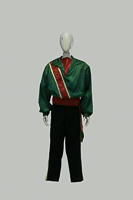
First Santa Clara uniform from the Bill Ives Collection Contributed by Jesse Amador
LOADING.....



























/thumb/Santa Clara Vanguard-043.jpg)








.jpg)
.jpg)
.jpg)
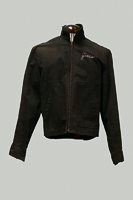
.jpg)
.jpg)
.jpg)
.jpg)
.jpg)
.jpg)
.jpg)
.jpg)
.jpg)
.jpg)
.jpg)
.jpg)

